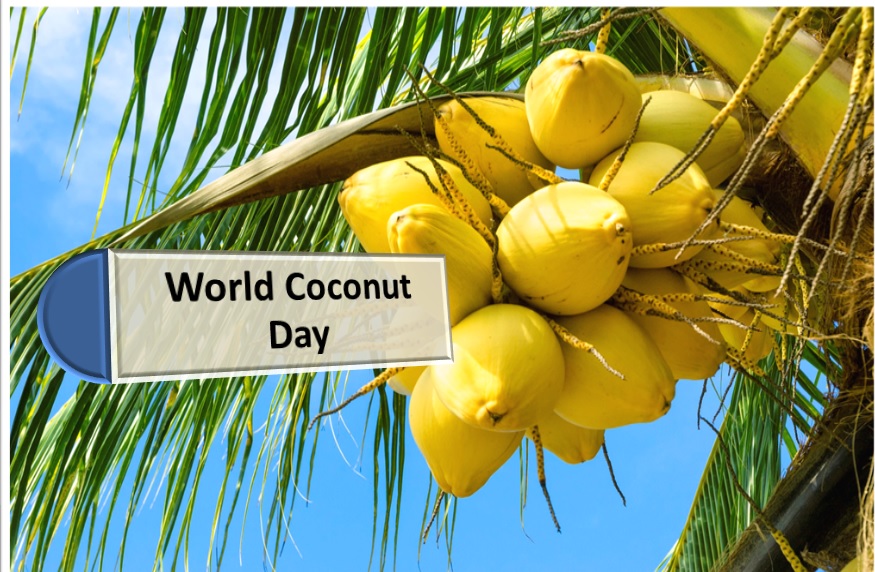World Coconut Day 2023: Theme, Interesting Facts, Celebration

World Coconut Day is observed every year on the 2nd of September. There are a variety of dishes that cannot be produced without coconut and coconut offers multiple health benefits as well. To celebrate the importance and benefits of coconuts, World Coconut Day began to be observed.
This special day also commemorates the establishment of Asian and Pacific Coconut Community (APCC), an intergovernmental organization of coconut producing countries.
World Coconut Day 2023 Overview
| Event | World Coconut Day 2023 |
| Date | September 2, 2023 |
| Day | Saturday |
| Declared by | Asian and Pacific Coconut Community |
| Purpose | To celebrate the importance and benefits of coconuts. |
World Coconut Day 2023 Date
Below mentioned are the upcoming dates for World Coconut Day for the next 5 years.
| Event | Date | Day |
| World Coconut Day 2023 | September 2, 2023 | Saturday |
| World Coconut Day 2024 | September 2, 2024 | Monday |
| World Coconut Day 2025 | September 2, 2025 | Tuesday |
| World Coconut Day 2026 | September 2, 2026 | Wednesday |
| World Coconut Day 2027 | September 2, 2027 | Thursday |
Interesting facts related to Coconuts
Here are certain interesting facts about coconut that you probably don’t know.
Coconuts can stay afloat over the ocean because of their water-resistant nature and can travel great distances.
Coconut oil has many benefits- it nourishes skin, improves digestion and reduces allergic reactions. The benefits are similar for man and dog as well.
Coconut water can be used as a substitute for blood plasma.
Every year, around 150 people are killed from falling coconuts.
The tallest coconut tree ever was measured to be 186 feet. It was measured after it fell on the ground.
On an average coconut trees are 98 feet long. Coconut trees of 60-80 feet are called as dwarf trees.
Indonesia, Philippines and India are the largest producers of coconuts in the world.
A coconut tree can produce up to 180 coconuts in one harvest year.
Coconut bowls made from outer shell of coconut are not only amazing looking but have natural benefits as well.
Multiple world records exist for peeling, piercing and breaking coconuts in seconds.
World Coconut Day Significance
The main significance of observing World Coconut Day is to commemorate the formation of the Asian and Pacific Coconut Community (APCC). The community in turn celebrates the importance and benefits of coconut in different forms, be it coconut water, oil, milk, husk, etc.
Thus the World Coconut Day celebrates the importance of both Asian and Pacific Coconut Community and the coconut itself and is observed every year on September 2nd.
History of World Coconut Day Observation
The declaration to celebrate World Coconut Day was adopted by Asian and Pacific Coconut Community in 2009. The date was chosen to mark the anniversary of formation of the community on the same day in 1969.
APCC promotes and manages the activities of the coconut industry in the Asia-pacific region. The first World Coconut Day was therefore observed on 2 September 2009 and is observed every year since then.
Check all special days of September
Asian and Pacific Coconut Community
The Asian and Pacific Coconut Community (APCC) is an intergovernmental organization that comprises of the Asian-Pacific coconut producing states. The motive of this organization is to “promote, coordinate and harmonize all activities of the coconut industry”.
It was earlier known as Asian Coconut C but when states outside Asia started joining the organization, the name was changed to Asian and Pacific Coconut Community. The member states of the APCC produce more than 90 per cent of the world’s total coconut production and handle their export.
History of APCC
The Agreement establishing the Asian Coconut Community was established in Bangkok on 12 December 1968 and signed by the countries of India, Indonesia, and the Philippines.
After its approval, the Asian Coconut Community came into existence on 9 September 1969 with headquarter in Jakarta.
World Coconut Day 2023 Theme
World Coconut Day is a day of global observance but is specifically celebrated with great enthusiasm in the Asian countries. Usually, there is a theme provided by APCC and the celebrations of the day revolve around this theme.
The theme for this year is ‘Coconuts: Transforming Lives’. People throw coconut based parties to celebrate this day which are mostly beach themed or tiki parties with coconut based decorations, drinks, dresses and much more.
Those who don’t like partying much or want to celebrate in a different way can cook delicious coconut based dishes and enjoy with their families and friends.
Top Ten Facts about Coconut
- Botanical Classification: Coconuts (Cocos nucifera) are the fruits of the coconut palm tree, which belongs to the Arecaceae family. They are not true nuts but rather a type of drupe.
- Geographical Distribution: Coconuts are widely distributed in tropical and subtropical regions around the world. They thrive in coastal areas with sandy soils and plenty of sunlight.
- Versatile Use: Every part of the coconut is useful. The water inside the coconut, known as coconut water, is a refreshing and hydrating drink. The white flesh, called coconut meat, is used in various culinary dishes, desserts, and products like coconut oil and milk.
- Cultural and Culinary Significance: Coconuts have significant cultural and culinary importance in many tropical countries. They are a staple ingredient in dishes ranging from curries to sweets, and coconut-based products are used in traditional medicine and cosmetics.
- Oil Extraction: Coconut oil is extracted from the dried coconut meat. It is rich in saturated fats and is used in cooking, skincare, and hair care. Virgin coconut oil, extracted without the use of chemicals, is particularly popular for its potential health benefits.
- Nutritional Value: Coconut meat is a good source of dietary fiber, vitamins (such as vitamin C, E, and some B vitamins), and minerals (including potassium, magnesium, and copper). However, it is also calorie-dense due to its high fat content.
- Coir Production: The fibers found between the hard outer shell and the coconut meat are known as coir. Coir is used to make a variety of products, including ropes, mats, brushes, and even soil-less growing mediums.
- Germination and Seed Dispersal: Coconuts have a unique adaptation for seed dispersal. They are well-equipped to float in water, allowing them to be carried by ocean currents to distant shores, where they can potentially establish new coconut palm trees.
- Longevity and Productivity: Coconut palm trees are known for their longevity, often living for 80 to 100 years or more. A healthy coconut palm tree can produce coconuts for decades, making it a sustainable source of food and materials.
- Cultural Symbolism: In many cultures, coconuts hold symbolic significance. They can represent fertility, prosperity, and even divine blessings. Coconuts are often used in religious ceremonies, rituals, and cultural celebrations.
FAQs
Saturday, September 2, 2023
‘Coconuts: Transforming Lives’
To commemorate the formation of Asian and Pacific Coconut Community on the same day.
On 9 September 1969




